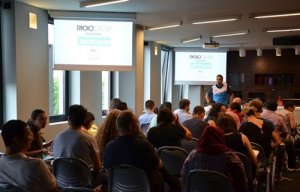
RadiciGroup for Sustainable Development Goals
The annual conference and mill visits for textile students at universities and colleges across the UK took place in Bradford from 16-17 October.
23rd October 2018
Innovation in Textiles
|
Bradford
Janet Prescott reports
The annual conference and mill visits for textile students at universities and colleges across the UK took place in Bradford from 16-17 October. Making it in Textiles (MIIT) 2018 is organised and financed by the major textile Guilds, The Worshipful Company of Weavers Initiated the programme under the late James Sugden. It is supported by The Campaign for Wool.
The experience for students has been honed and streamlined over time: students have increasing knowledge of opportunities offered by the textiles industry in its widest sense, and an even greater one by the time they have left the conference.
Sheila-Mary Carruthers, internationally regarded design consultant, urged students to consider opportunities, which textiles offer: manufacturing technology, IT, social media, buying and selling in fashion and interiors all requiring qualities of persistence and flexibility: no job too small or unusual to be used as a stepping stone
Margo Selby designer, artist and famous eponymous design brand, trained at Chelsea College and the RCA. She recounted hard realities setting up and growing an international business, how it fluctuates and grows, and the importance of staying creative; “keep weaving”.
Harriet Wallace-Jones and Emma Sewell, partners in Wallace Sewell design duo set up 1990, graduated from RCA, renowned for their colour, structure and highly-coveted scarves. Their subject was Colour – complexities, research and knowledge. They work exclusively with the British textiles industry in varied ways, presently designing fabrics for individual London Underground lines.
Richard Brook, MD Wooltex UK, first a day-release student in Huddersfield, progressed to MD of Wooltex UK, trading with prestigious interior firms internationally. The modern dyehouse was his focus, rigours and ultimate satisfaction of sustainable practices, the importance of minimising environmental effects.
Richard Humphries, of Humphries Weaving, a regular speaker at MIIT, adept at entertaining the audience, created a beguiling scenario describing how his intricate woven silks are used in sumptuous designs for palaces and dresses, cars and yachts, clients including royalty and occupants of great houses, pieces varying from large to very small exquisite and complex, fabrics and wallcoverings in shining silks.
Finishing the Cloth wrapped up the session; Paul Johnson, accomplished speaker and MD of WT Johnson, explained the treating and nurturing of the cloth for iconic names of Europe and the UK, Versace, YSL, Tom Ford, Hermes, Gucci, for instance, explaining that without finishing, “even the most excellent fabric does not reach its potential”, “we build on all the hard work and make sure the value of the supply chain is delivered”.

Mill visits to Pennine Weavers, and Stanley mills, Marton Mills, Roberts Dyers and Finishers, Antich & Sons, and WT Johnson, AW Hainsworth and Alfred Brown, Abraham Moon and Laxtons Specialist Yarns, all in the Yorkshire area, revealed the prestige of the mills, which are thriving in a new era.
Students remarked these were eye-openers, sometimes the first time they had been inside such important commercial mills doing millions of pounds worth of business.
Six graduates now successfully working and making it in textiles at a high level shared experiences with the undergrads. Two alumni of TexSelect, the intense mentoring programme for selected designers, were included; Andrew Stevenson, of Paul Smith, Laurence Alder, of John Spencer Textiles.
One could say that Making it in Textiles shows the ancient cloth guilds spreading influence across the centuries to inspire the young, and that making textiles can enable them to “make it in textiles”.
A neat equation.

Business intelligence for the fibre, textiles and apparel industries: technologies, innovations, markets, investments, trade policy, sourcing, strategy...
Find out more